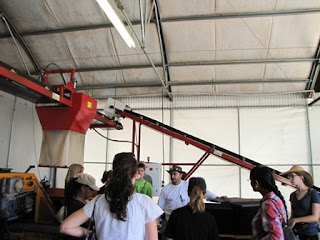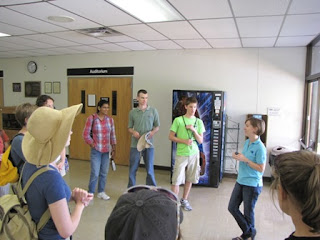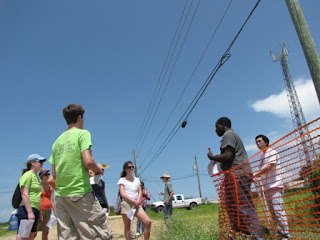Late last week the Water Resource Engineering team completed the first phase of the field plot study site preparation.
With all hands on deck (at one time or another), by mid-day Thursday, what began as a pristine 4620 sq. ft (or ~429 sq. m) piece of land, had taken the form of 16 15’X15’ square plots with the beginnings of irrigation pipe running to each square.
Day 1: and you will know us by our trail of markings…and re-markings

The first day’s objective was to bring to life the plot that had until then existed only as an intricately detailed design and specs graphic.

Despite our best efforts, however, we soon learned that measuring and marking a perfect square on a well-worn field plot is a rather complicated affair.


Eventually, we discovered the utility of a time-saving tool invented some time ago: the right angle! First, Isaya’s version, combining both ancient geometry and measuring tapes.

Later, the actual physical incarnation came into play. This certainly sped up the process of measuring proper lengths.
For each length, rebar was hammered into the ground at each end, string attached, and paint sprayed along the distance.

In addition, thanks to some on-the-fly redesign work courtesy of Tina, who saw past the old assumptions of valve location, inter-plot marking work was streamlined and allowed us to leave a more-or-less accurately marked field plot ready for trenching by day’s end .

Pipes arrive at mid-day.
 Day 2: let the stormy clouds chase, everyone from the place…(except Manny!)
Day 2: let the stormy clouds chase, everyone from the place…(except Manny!)
Manny in medias res on trench day
Day 2’s objective – trench for the plot’s main water line, for the 16 rep water lines and for the future timer power supply. Drafted into the Water Resource Team’s ranks for the day, for his skill with a trencher and his ability to keep cool before seemingly insurmountable obstacles, intrepid TREC field crew member Manny Soto!

The trencher kept us plenty busy – we shoveled loose soil left in its wake and leveled out live wire and water line areas where it could not enter.
Soon after mid-day, the rain clouds rolled in, but that didn’t stop Manny. He simply broke out his large umbrella and continued on, trenching line after line until the entire area was finished and ready for the pipe to be laid for 16 plots! THANK YOU, Manny!

 Day 3: Nicki’s birthday! (oh yeah…pipe-laying day)
Day 3: Nicki’s birthday! (oh yeah…pipe-laying day)
Could there be a better way to commemorate 23 years on the planet than cutting and gluing PVC pipe in 90+ degree heat?
The PVC pipe (1.5” for the main line and ¾” for the secondary lines to the plots) was laid out next to the trenches, cut, glued, and placed in the trenches. The main line was installed first, and then the secondary lines, beginning with the plots furthest from the main line.
After all of the pieces (pipe, elbows, & tees) for each plot were glued together, they were placed in the trenches and the pipe was labeled for each plot.

Next step: Phase 2
· Finish building and test lysimeter prototype
· Piecing together water-meter/valve/pressure gage set-ups in the lab
Acknowledgments

I cannot thank everyone (Manny, Jorge, Mike, Isaya, David, Tina, Teresa, and Dr. Kati) enough for all of the hard work and effort put into making this plot study (once only a sketch) an actual reality! Even the simplest things on paper take so much effort to actually make happen! In the end, it will all be worth it! I know it’ll be the prettiest lil’ piece of grass at TREC!
Nicole Dobbs










































